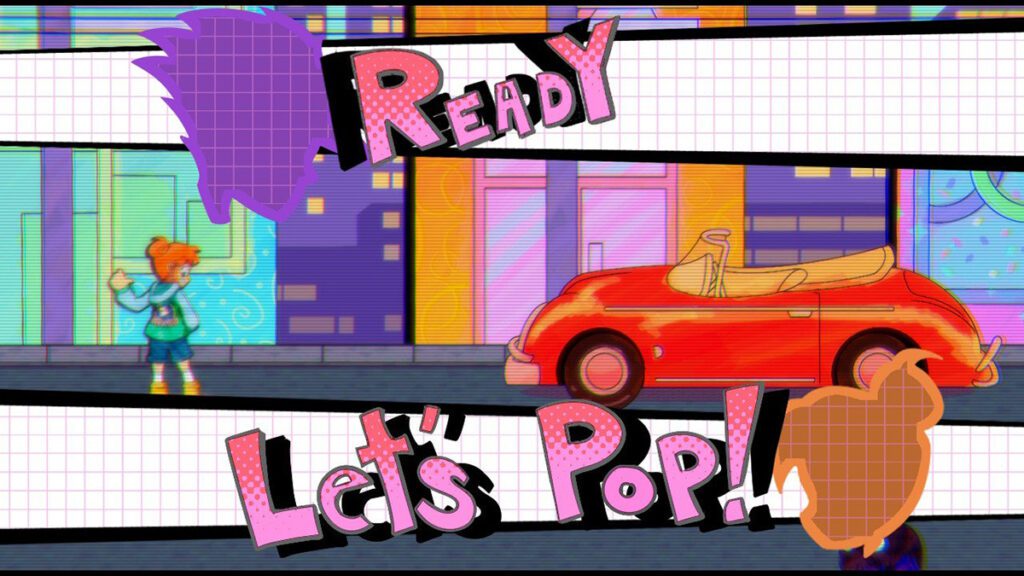Developed by: Funky Can Creative
Published by: Funky Can Creative
Released: January 26, 2022 (Nintendo Switch)
Popslinger oozes style and charm. Funky Can Creative’s PopSlinger invokes the arcade action of the early 1990’s. Bright, neon characters and bubbly pop music welcome players into the action. Unfortunately, like an early 90’s arcade, the inviting and exciting first impressions fizzle out. Although the sense of style remains, gameplay turns from intense to frustrating.
Bubbly Action
Popslinger is a side-scrolling action game that creatively blends ideas from other genres. The main character, Ria, starts with a soda gun to blast through levels of otherworldly blobs. This run and gun action slows when levels gate progress until all enemies are defeated. Popslinger locks camera scrolling, like in a brawler, until the enemies are cleared. Clearing the enemies is a mix of rhythm and puzzle game elements. Shooting enemies of the same color provides perks and buffs and is central to the gameplay.
Consequently, defeating the desired colored enemies creates a combat flow that is more involved than mindlessly clearing the screen. Hitting four enemies of one color and then four of a different color can provide a mirrored attack, turret, or shield bubble. Hitting eight of the same color provides alternative buffs like healing. Funky Can Creative made an engaging combat system that requires planning for high scores and survival.
Shaken Combat
Popslinger’s camera system and difficulty spikes hamper this unique and challenging combat. For a game that invokes ’90s arcades, Popslinger‘s spike in difficulty is expected. Unfortunately, the tight, close camera creates navigation challenges related to anticipating and dodging enemy attacks. Taking damage also breaks the color chain of bonuses, resetting the chain. This results in lost progress toward those much needed perks.
Popslinger’s enemies gain shields in later levels. Players destroy shields by blasting them with one of the color-coded weapons, including blasters, spread shotguns, beam cannons, and explosive projectiles. Combat becomes frenetic as players need to switch weapons to break shields and juggle enemy types to create color chain combos.
At first, this challenge incentivized replay. Building muscle memory and pattern recognition as one would in a classic arcade game. Ultimately though, the constrictive camera restricts mastery of these challenges.
Camera Concerns
The camera stays zoomed in on the expressive main characters. While this allows for large, detailed characters, it results in the characters occupying significant screen real estate. Consequently, Popslinger’s limited screen space prevents the ability to plan out color enemy attacks.
The camera does zoom out, at the start of a wave, to show the player the space they are locked into and the enemy spawn locations. Maintaining this wider camera angle would allow the player to anticipate attacks and understand where the enemy attacks came from.
The offscreen enemy attacks also factor into boss fights. Each boss has a series of patterns to recognize and anticipate. Unfortunately, the challenge most often comes from the camera and not the boss design. Off-screen attacks and the inability to determine attack angles led to many restarted boss battles.
Amazing Atmosphere
The gameplay criticism is difficult to swallow given the strong sense of style created by Funky Can Creative. Popslinger’s bright and neon color pallet invokes the time period of the game. The visual design utilizes fake VCR tracking static lines throughout story cut scenes. This design choice grounds the game in the early 1990s and provides Popslinger its unique design.
Popslinger’s music is full of energy. The mix of synth and pop drive the action. I’ve found myself coming back to Popslinger for the art style and the music in spite of the frustrating combat.
Patch Potential
If the camera limitations can be addressed in a future patch, Popslinger’s enjoyment could bubble over. Unfortunately, the game is out for about a month without any news of an adjustment to the camera.
Like other early `90s arcade games, the opening levels are fun and interesting. But soon cheap hits and repeated deaths beg for more quarters. While Popslinger doesn’t require quarters, it does require more patience than most players may endure. This is a shame though because Popslinger’s characters and story are interesting. There is depth to the main characters and story of Ria and Gin if players are willing to fight against the camera and level design to see it.
Popslinger Fizzles Out
Popslinger lured me back again and again since launch. Unfortunately, just like a quarter munching arcade cabinet, Popslinger drove me away with its’ tight camera and narrow field of view. If that can be patched, Funky Can Creative’s unique color-coded combo system and artistic design can shine. Until then, I’ll quench my thirst with the official soundtrack.




